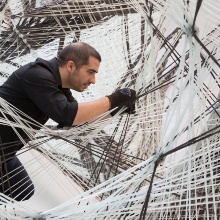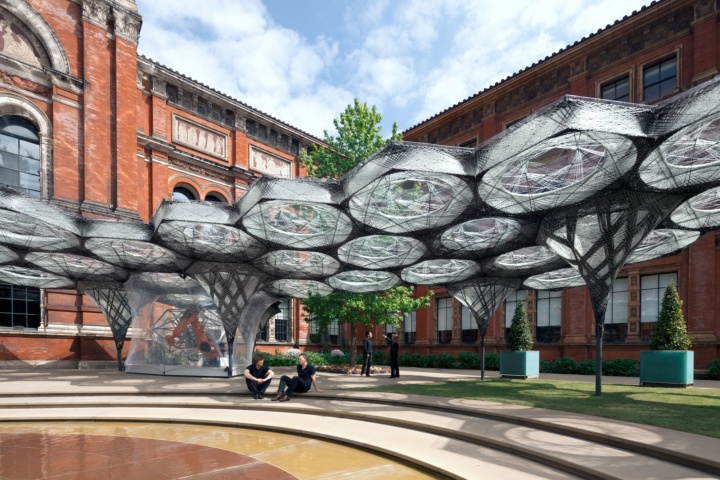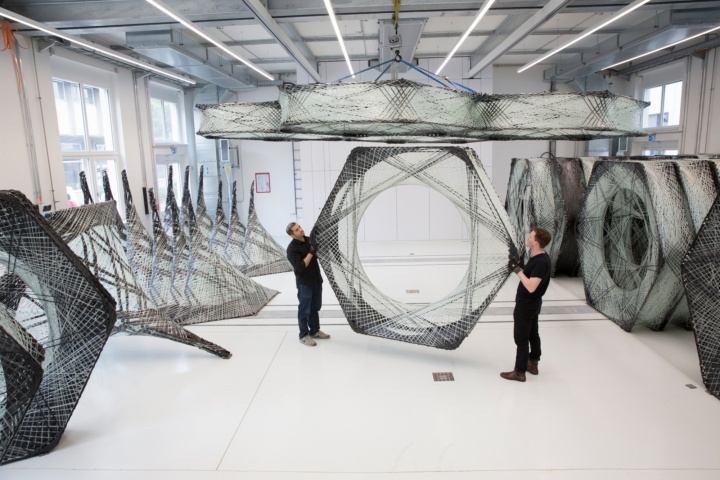Unlike humans, nature often constructs things with fibres: plants from cellulose, insects from chitin, and vertebrates from collagen. Why not adopt the same principle in the field of construction researchers at the University of Stuttgart asked themselves. In 2016, a pavilion created on the basis of their novel method was the main attraction at the Victoria & Albert Museum in London.
The Victoria & Albert Museum was founded 165 years ago to showcase the influences of industrialisation on society. In 2016, the museum wanted to exhibit the world’s biggest art and design collection to emphasise how engineering has characterised and shaped the 20th century. The “Elytra Filament Pavilion” in the courtyard, which was the main attraction for the public during this “Engineering Season” originated at the University of Stuttgart. The design for this exhibit is based on the inner structure of beetle wings. It won the competition for the best exhibit in the John Madejski Garden for the Stuttgart-based team.
“Our idea”, explains Professor Achim Menges, architect and head of the University of Stuttgart’s Institute for Computational Design, “was to demonstrate how engineering and design could come together in future.” To create the pavilion, the team led by Professor Menges and construction engineer Professor Jan Knippers from the Institute of Building Structures and Structural Design, refined a robotic process – the design was produced by a specially programmed piece of software. Then an industrial robot wound pieces of glass and carbon fiber coated in epoxy resin around a hexagonal substructure. The trick: the robot did not work to a set design. Instead, the fibers positioned themselves automatically during the winding process.
This produced a total of 45 complex hexagons, each with a unique fiber structure and adapted to its own specific function within the pavilion roof. This approach was completely new for the team: “There is a seamless flow from design to production”, says Professor Menges. The scientists had copied the construction method from the elytra or hardened forewings of native beetle species. These consist of an upper and lower shell that are bound together like flattened honeycombs. Unbroken chitin fibers provide the necessary strength at the contact points between the platelets, and the wings are hollow in between.
Based on this template, the team was able to produce a highly rigid, but extremely lightweight structure. The entire pavilion that spanned an area of 225 square meters, weighed just 2.5 tonnes – as much as just two square meters of brickwork on the façade of the Victoria & Albert Museum. For Menges, the Elytra Filament Pavilion embodies “the unified conceptualization of architectural design, engineered construction and state-of-the-art production methods”. It is typical for the trans-regional Collaborative Research Centre SFB/TRR 141, for which Jan Knippers is the spokesman.
The interdisciplinary and integrative approach in this area brings together architects and engineers from the University of Stuttgart, biologists and physicists from the University of Freiburg and geo-scientists and evolutionary biologists from the University of Tübingen. The researchers are currently working on a new pavilion that takes the concept further: “We now have two widely spaced robots and a drone that flies the fibres from one to the other”, Menges reports. At some stage in the future, machines may even be capable of building complete stadium covers in this manner. The prototype will be on display at Campus Stadtmitte in the spring of 2017. Daniel Völpel




